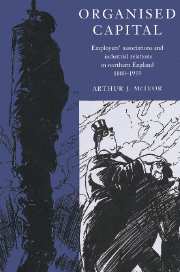Book contents
- Frontmatter
- Contents
- List of maps and tables
- Acknowledgements
- List of abbreviations
- Introduction
- Part 1 Setting the scene
- 1 Context and historiography
- 2 The legacy: origins of employers' associations
- Part 2 Forging employers' organisations, 1880–1920
- Part 3 Reacting to the economic slump, 1920–39
- Conclusion
- Bibliography
- Index
1 - Context and historiography
Published online by Cambridge University Press: 14 October 2009
- Frontmatter
- Contents
- List of maps and tables
- Acknowledgements
- List of abbreviations
- Introduction
- Part 1 Setting the scene
- 1 Context and historiography
- 2 The legacy: origins of employers' associations
- Part 2 Forging employers' organisations, 1880–1920
- Part 3 Reacting to the economic slump, 1920–39
- Conclusion
- Bibliography
- Index
Summary
This chapter has two parts. The first aims to set the conceptual context for the text that follows, outlining what employers' associations are and what they do, briefly reviewing prevailing theories of employer organisation and behaviour, and the historiography of this topic. This will construct a framework of reference which will be returned to and fleshed out as key themes are interwoven within the text. The second section will narrow the focus to the geographical region of north-west England, providing some background information on the three industries chosen for intensive investigation: cotton manufacturing, engineering and building. Those readers who are familiar with this material might like to proceed directly to the next chapter. I start with some comments upon the nature of nineteenth-century British capitalism; the soil from which employers' organisations emerged.
Employers' organisations
As British industrialisation proceeded through the eighteenth and into the nineteenth centuries the dominant social figure was the aspiring capitalist entrepreneur: fiercely independent, individualistic and unequivocally committed to notions of unfettered free market competition. Within Victorian society private provision of capital was widely regarded as an act which conferred sacrosanct rights upon employers. Central to such prerogatives was the right to employ whom they thought fit, under terms of labour contract unilaterally determined by themselves, with the freedom to manage this labour without external interference or constraint. Such autonomy was deemed a fundamental prerequisite for the successful, profitable prosecution of a business. In reality, however, such control was rather more diffuse, and managerial prerogative could be interpreted in a wide variety of ways.
- Type
- Chapter
- Information
- Organised CapitalEmployers' Associations and Industrial Relations in Northern England, 1880–1939, pp. 13 - 35Publisher: Cambridge University PressPrint publication year: 1996



